Using the best lump charcoal you can get your hands on is paramount if you want to maximize food flavor and bring out the natural fragrances because – let’s face it, everyone loves a good old grill cookout. Grilling brings us together, eating simple and delicious food, hanging around the fire, talking, and bonding. High-quality meats, mushrooms, and veggies are important, yes, but people often forget about the fuel source.
We tested out some of the most popular lump charcoal brands, and decide to compile essential info into these lump charcoal reviews. Besides the brands themselves, we are going to touch upon some important stuff, tricks, and tips on how to decide which lump charcoal you want to use for grilling, searing, or smoking. Let’s get right into it.
See The Quick Comparison Chart
What Can You Cook with Lump Charcoals?
 What can’t you? If you have a portable grill, a large outside griddle, or even a kamado grill, lump charcoal is a great source of heat. Of course, the preferences vary from cook to cook, but one thing is for certain: when a high temperature is on-demand, lump charcoal will deliver. Some even go as high as 1300 degrees Fahrenheit. We think that lump charcoal is ideal for smoking meat and veggies, because smoking takes time and patience, and it is the best way to transfer that unique dash of wood flavor to your food.
What can’t you? If you have a portable grill, a large outside griddle, or even a kamado grill, lump charcoal is a great source of heat. Of course, the preferences vary from cook to cook, but one thing is for certain: when a high temperature is on-demand, lump charcoal will deliver. Some even go as high as 1300 degrees Fahrenheit. We think that lump charcoal is ideal for smoking meat and veggies, because smoking takes time and patience, and it is the best way to transfer that unique dash of wood flavor to your food.
Lump charcoal is popular with smokers, yes, but that is not the only area it excels in. Just regular grilling is on the table too. Even though griddle owners do not like to admit it, large outdoor griddles work great if fueled by lump charcoal. Besides, have you ever tasted a full eggs and bacon breakfast cooked on charcoal? We guarantee that it is a unique experience, no matter the simplicity of the food you cook.
Lastly, another strong suit of lump charcoal is searing. The process of quickly burning the meat to a crust, while leaving the inside medium-rare, is one to be practiced. And, the best way to get the hand of it is to use charcoal. It will provide high heat on demand, raising the temperature quite high without the long wait.
To summarize the answer to this broad question: it depends. The only thing that keeps you back from making various recipes, exotic and regular, is your imagination and experience. The later is obtained easily by simply grilling, and lump charcoal will definitely be a solid partner.
Best Lump Charcoals Comparison Chart
| PRODUCT | DETAILS | ||
|---|---|---|---|
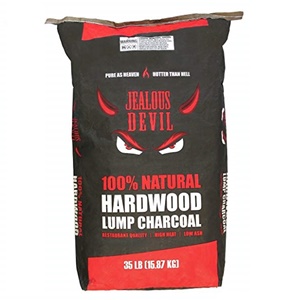 | JEALOUS DEVIL ALL NATURAL HARDWOOD LUMP CHARCOAL – 2 X 35LB |
| View On Amazon |
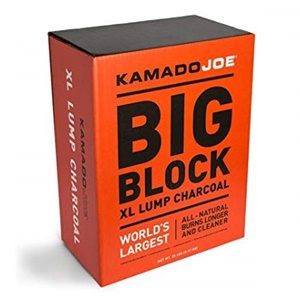 | KAMADOJOE KJ-CHARBOX HARDWOOD EXTRA LARGE LUMP CHARCOAL |
| View On Amazon |
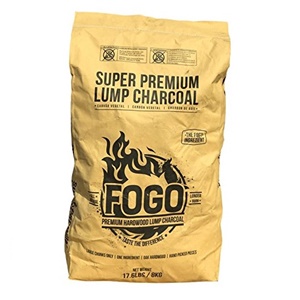 | FOGO SUPER PREMIUM HARDWOOD LUMP CHARCOAL |
| View On Amazon |
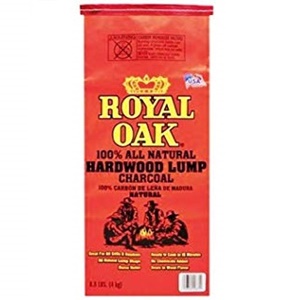 | ROYAL OAK 195228071 LUMP CHARCOAL |
| View On Amazon |
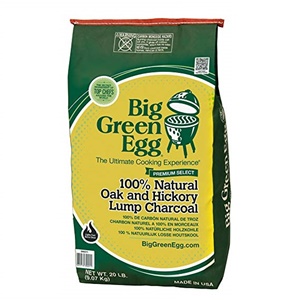 | BIG CP 20-POUND BAG OF NATURAL LUMP CHARCOAL |
| View On Amazon |
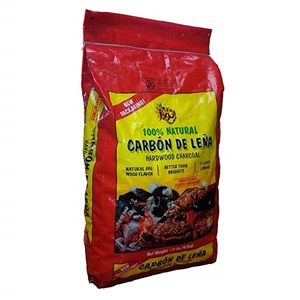 | FOGO! CARBON DE LENA HARDWOOD CHARCOAL 8.8LB BAG |
| View On Amazon |
Best Lump Charcoal Reviews
1. Jealous Devil All Natural Hardwood Lump Charcoal – 2 x 35LB
 First up we have a double-bag pack of natural hardwood lump charcoal from Jealous Devil. Each bag is made with high-quality, heavy-duty kraft paper, which ensures no breakings or spilling. They weigh 35 pounds each, making this a total of 70 pounds of lump charcoal.
First up we have a double-bag pack of natural hardwood lump charcoal from Jealous Devil. Each bag is made with high-quality, heavy-duty kraft paper, which ensures no breakings or spilling. They weigh 35 pounds each, making this a total of 70 pounds of lump charcoal.
The wood burned to make this charcoal is from South America, and it can withstand over 4 hours of intense cooking time or 20 hours of smoking time. Even though it is a mix of several hardwood types, the taste that sticks to the food cooked on this charcoal is mild and somewhat sweet. This makes it great for any type of meat you would like to grill or smoke. The maximum temperature that can be achieved with this lump charcoal is 1170 degrees Fahrenheit.
Jealous Devils claims that this type of coal is the most versatile and that with that feature it always gives “restaurant-like” results, which is quite true due to the nice mild flavor it gives off.
2. KamadoJoe KJ-CHARBOX Hardwood Extra Large Lump Charcoal
 Next up, we have lump charcoal made by one of the most famous grill makers around the globe, Kamado Joe. This particular sort of lump charcoal is known globally for its delivery and consistency. It comes double packed in a box and heavy-duty paper bag, for extra security from humidity and crushing.
Next up, we have lump charcoal made by one of the most famous grill makers around the globe, Kamado Joe. This particular sort of lump charcoal is known globally for its delivery and consistency. It comes double packed in a box and heavy-duty paper bag, for extra security from humidity and crushing.
With this, you get 20 pounds of lump charcoal. Wood burned to get this high-quality fuel is Argentinian hardwood, ecologically processed. The majority of pieces are large, which is great, however, there are some smaller pieces, which Kamado Joe recommends being used for better ignition.
This brand of charcoal can last for 5 or more hours of serious grilling, and it enhances your food with a strong flavor of wood, meaning that it has some oak inside, even though it’s a mix of Argentinian hardwood. The top temperature this lump charcoal can achieve burning is somewhere around 1100 degrees Fahrenheit.
3. Fogo Super Premium Hardwood Lump Charcoal
 Another popular choice among the grill masters that prefer mild and mellow flavors is this oak lump charcoal from Fogo. This lump charcoal oak mix comes in a heavy-duty paper bag, weighing a total of 17.6 pounds. The bag is extra strong for more humidity protection.
Another popular choice among the grill masters that prefer mild and mellow flavors is this oak lump charcoal from Fogo. This lump charcoal oak mix comes in a heavy-duty paper bag, weighing a total of 17.6 pounds. The bag is extra strong for more humidity protection.
Now, it is quite rare for oak charcoal to give out a mild flavor. However, the people at Fogo found a great burning technique, which makes this charcoal restaurant grade. They even managed to lower the max temperature, making this lump charcoal ideal for smoking and slow cooking. It can withstand around 4 hours of grilling, and 20+ hours of smoking.
The strong suit of this lump charcoal is the rate of ignition. It takes only 15 minutes for the whole batch to reach the optimum fire rate and temperature, making it great for quick grilling sessions.
4. Royal Oak 195228071 Lump Charcoal
 Even though the name of this lump charcoal brand suggests the coal origin, Royal Oak made a great mixture, with oak being the major component. It comes in a heavy-duty paper bag for extra protection, and it weighs a total of 8.8 pounds.
Even though the name of this lump charcoal brand suggests the coal origin, Royal Oak made a great mixture, with oak being the major component. It comes in a heavy-duty paper bag for extra protection, and it weighs a total of 8.8 pounds.
This lump charcoal brings that true smell and flavor of grill we all know. This is thanks to the mixture of four different renewable hardwoods: Oak (main), hickory, walnut, and maple. Having such a mixture allows it to burn at higher temperatures, which is ideal for searing and heavy-grilling.
The best thing about this lump charcoal is that it leaves a smaller amount of ash after use, as opposed to the other similar types from its price range. It lights pretty quickly, and the mixture is made of mostly larger pieces of charcoal. The temperature goes up to 1200 degrees Fahrenheit, making it quite popular with steak chefs.
5. BIG CP 20-pound bag of natural lump charcoal
 If you ever used, or even just stumbled upon a good kamado grill, chances are that you stumbled upon Big Green Egg brand. They specialize in smoking and long cooking, and their lump charcoal lives up to the name. The heavy-duty paper bag is double sealed, and it packs a total of 20 pounds of lump charcoal.
If you ever used, or even just stumbled upon a good kamado grill, chances are that you stumbled upon Big Green Egg brand. They specialize in smoking and long cooking, and their lump charcoal lives up to the name. The heavy-duty paper bag is double sealed, and it packs a total of 20 pounds of lump charcoal.
The wood used to make these lumps is part oak part hickory, with oak being the dominant flavor. This tells us that the flavor, this charcoal will bring to the table, will mostly be strong, slightly bitter and that the smell will also be prevalent. Because kamado grills are used for slow cooking and smoking mainly, this lump charcoal was made to last for a long time. It can withstand 6+ hours of grilling, and 25+ hours of smoking, depending on your wishes and grilling skills.
6. Fogo! Carbon de Lena Hardwood Charcoal 8.8lb Bag
 Last on this list, we have another popular lump charcoal package coming from Fogo again, with this one being slightly more affordable. It is packed in a heavy-duty plastic-coated bag, making it extra-secured against humidity. The bag weighs a total of 8.8 pounds.
Last on this list, we have another popular lump charcoal package coming from Fogo again, with this one being slightly more affordable. It is packed in a heavy-duty plastic-coated bag, making it extra-secured against humidity. The bag weighs a total of 8.8 pounds.
The bag contains a mix of smaller and larger pieces, making the charcoal more suitable for grilling rather than smoking and slow cooking. This South American mix of renewable hardwood light up pretty easily and lasts for 3+ hours of heavy grilling on high temperatures. Searing the meat is another strong suit of this lump charcoal, but its versatility depends on your preferences, of course.
Even though the majority of the mix is burned oak tree, this lump charcoal will enhance your food with softer, milder flavors, which is somewhat rare for this type of tree.
What is Lump Charcoal?
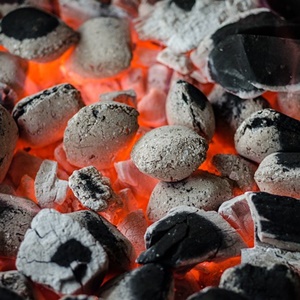 So, we are sure that you have definitely seen lump charcoal at a BBQ party, or maybe you have used some yourself by now. However, not many people think about what lump charcoal is, and the journey to a skilled grill chef begins with lump charcoal and its utilization. To put it simply, lump charcoal is burnt hardwood. But the burning process comes with a twist: it is done in a special environment, achieving multiple effects.
So, we are sure that you have definitely seen lump charcoal at a BBQ party, or maybe you have used some yourself by now. However, not many people think about what lump charcoal is, and the journey to a skilled grill chef begins with lump charcoal and its utilization. To put it simply, lump charcoal is burnt hardwood. But the burning process comes with a twist: it is done in a special environment, achieving multiple effects.
The sole purpose of making lump charcoal in such conditions is keeping the caloric value (burning value) of the wood intact. Manufacturers do not just burn wood, they tend to it in order to make quality charcoal for your grill. While burning, all water and natural oil residue are evaporated, which furtherly increases the durability and structure of the lumps themselves. The process is sometimes repeated even, but that is a scenario less likely to happen.
Hardwood used for making lump charcoal can originate from various places, however, two main sources are the most common: industrial forest areas and lumber mills. Wood originating directly from the forests are getting rarer by the day, for obvious environmental reasons, and lumber mills were proven to be a valid source of high-quality hardwood, under several conditions that are:
- The wood provided must be in whole lumps because the volume tends to shrink a bit during the making process.
- There must be no foreign objects (nails, chemicals, plastic, etc.) inside the hardwood supply, no matter the origin.
- Even though there can be a mix of different sorts of hardwood, the plant species must always be known, no matter how many are inside.
Lump charcoal made a comeback since the technology behind it got cleaner, and the hardwood source origin became controlled and regulated. There are some downsides which we are going to touch upon later.
Lump Charcoals vs. Briquettes
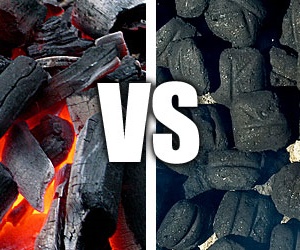 Ah yes, the yearlong debate: charcoal or briquettes. We would like to tell you that there is a simple “A over B” answer, but the situation is far from simple. Like many other fuels out there (gas, propane, electricity), both lump charcoal and briquettes bring different things to your BBQ party.
Ah yes, the yearlong debate: charcoal or briquettes. We would like to tell you that there is a simple “A over B” answer, but the situation is far from simple. Like many other fuels out there (gas, propane, electricity), both lump charcoal and briquettes bring different things to your BBQ party.
The most important thing that we should always care about is taste, and when it comes to it, lump charcoal takes the cake. Let’s put it like this: you want your food to keep its taste (through juices and spices), but you would also like to enhance that taste by grilling it, using some sort of fuel.
Lump charcoal will do just that: it will let the original taste dominate, but it will add something unique to the whole flavor palette. Usually, it is the smoky taste we all like, and that got us in the grilling game in the first place. It can also be a unique flavor that some sorts of hardwood leave behind while burning. The same cannot be said for briquettes. They are made to burn controllably and in order to do that some flammable chemicals are added. That is why in the taste game, charcoal wins by a large margin. Using briquettes, you will certainly have a slightly chemical taste on your meat or veggies, and, let’s be honest, nobody wants that.
What is the debate about?
You must be wondering where’s the debate then, and why is “lump charcoal vs. briquettes” still a dilemma nowadays. Well, we did say that the answer is not that simple, and the choices are plenty for both fuel types.
Charcoal has the feature of heating up pretty quickly, and it can go up to extremely high temperatures. However, when it comes to fire stability, briquettes take the win. Some cooks require absolute precision from their fuel source, and briquettes deliver. There’s no easier way to put it: briquettes can burn on much more stable temperatures and, are controlled better, than lump charcoal. But, do not forget, that with enough experimenting and learning, you can have similar heat results with lump charcoal as well.
Lastly, a somewhat big difference between these two burning fuels is the shape. Charcoal, as you can conclude from the name of this guide, comes in lumps, and briquettes are often made to be smaller, standardized pieces. When we are talking about smoking food, especially in kamado grills, the larger the chunks (or lumps), the better. Briquettes can rarely approach this challenge with success.
Advantages and Drawbacks of Lump Charcoal
You have probably already figured out some of the features that you should expect from this fuel source. Lump charcoal has been around for millennia, and it has specifications to attest to its long-lasting popularity. However, nothing is perfect, and we think that knowing both sides of the coin is the best way to go, because knowledge is power after all. So, lets put up a couple of lists, marking all the ups and downs of this remarkable fuel source.
1. The Advantages of Using Lump Charcoal
Any experienced BBQ chef will tell you that picking the correct type of fuel for your grill or smoker is equally important as are the spices, ingredients, and cooking time. And this could not be more correct. Lump charcoal brings a bunch of good things to your BBQ party, making it a unique experience.
1.1. Longevity
Lump charcoal tends to have the longest burn time among coal types of fuel. It can endure cooking sessions longer than 3 hours with ease, making it a great asset, especially for people who grill often and for a lot of people. Other types of burning fuel will often need more refills and more tending to than lump charcoal.
1.2. Flavor
Ah yes, the unique taste of smoke in your food. The good kind of course. Lump charcoal is often the number 1 choice for smoking meats and veggies. Why? Because it gets the grill hot fast and keeps it that way for a long, long time. You control the heat by air venting, and the smoke does the rest. Many other products tried to achieve this level of flavor, but nothing beats the original taste source.
1.3. Reusability
This feature appeals more to the economic side of things. Charcoals like this can be reused when not burned entirely. All you have to do is close the grill, choke the fire in an air-free lock, and you are set for tomorrow. This feature saves money, yes, but it also makes camping trip grilling sessions much easier.
1.4. Less flare for more heat
This essentially means that charcoal has less chance to flare up and make a mess than the other fuels out there, especially gas. This is amazing considering the fact that it brings the highest temperatures to your grill’s heart.
1.5. Sparks
Charcoal tends to make fewer sparks, depending on the quality of course. Extra sparks from the flame can often ruin the meat taste, and lumps that are well-made will not give off any sparks at all, making it extra convenient for people who like to take their time preparing food on their grills.
2. The Drawbacks of Using Lump Charcoal
As we already mentioned above, nothing is perfect, and that applies to lump charcoal as well. Some downsides are well-known, and some are more intricate. In order to not get surprised, here are some drawbacks to expect:
- Carbon footprint – Lump charcoal is 90% carbon, and that brings some issues along. Burning charcoal leaves a greater carbon footprint on the environment than natural gas (or propane). Better brands tend to lower this by better regulations, but it is still harmful to some extent. That is why it is important to get natural lump charcoals because they are known to have quite a lower carbon emission rate.
- HCA warnings – HCA is a compound in the food that some relate to cancerous diseases. But take this with a grain of salt. Nobody ever got sick because of grilled food directly, and people tend to blow the HCA warnings out of proportions when it comes to charcoal. To ease your mind in the case of a dilemma, you can always shorten your cook and exposure time by slicing the ingredients to thinner and smaller pieces.
- Temperature control – This is not that big of a deal for people who are already into the grilling game. However, lump charcoal can be a bit difficult to use for first-timers. It is powerful and extremely potent when it comes to heat production, so make sure to practice a bit. This especially goes out to people with kamado type grills, because once you go over the wanted temperature, you will have to wait for a while in order for the charcoal to cool down.
Lump Charcoal Buying Guide
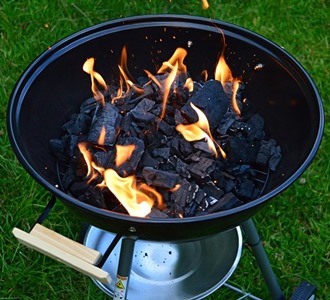 Now that we have seen the essential regarding this fuel source let us delve into all the things you should consider when getting a bag of charcoal for yourself. There are a lot of choices out there, and the more info you have, the sooner you will be eating those delicious grilled steaks.
Now that we have seen the essential regarding this fuel source let us delve into all the things you should consider when getting a bag of charcoal for yourself. There are a lot of choices out there, and the more info you have, the sooner you will be eating those delicious grilled steaks.
1. Lump Size
This might come off as common sense, but the size and shape of lumps you get in the bag matters a lot. Some grills need larger chunks to be placed not only for heat but as an important part of heat retention inside the coal burning chamber. Aim for the biggest lumps you can get your hands on, and be careful not to break them while storing the bag in your attic or basement.
If you by any chance get a bag with pieces of inconsistent size, it is possible that the charcoal got smashed during transport. Give it another chance, and if this continues happening, it is time to change the brand or contact the provider. It is true that different sorts of hardwood make for different sizes and shapes of lump charcoal, however, good coal will always stay whole if stored and transported properly. Which brings us to the next important topic to cover.
2. Taste Changes for Different Wood Species
It is no secret that different sorts of wood bring different tastes to the table. It usually takes time to learn what the whole palette woods get you, but we can give you some general guidelines, so you know where to start. This can best be tested out by cooking with homogenous lump charcoal.
2.1. Birch
This is the high risk – high rewards type of wood. People usually use it to smoke both salt and freshwater fish. However, if the carbonization of the wood is not done properly, it may add a bitter flavor to the meat. So, make sure to test a sample before you go all out with the ingredients you wanted to cook with this kind of charcoal.
2.2. Oak
It acts as the main ingredient of most lump charcoal mixes out there. It is a type of flavor you have surely tested. Oak tends to enhance the grilled food with a strong, slightly bitter taste, and an even stronger flavor. This is usually the taste that gets people into grilling in the first place. A lot of people often mix it with the next sort on our list.
2.3. Hickory
Considered one of the greatest grill taste enhancers (next to oak), hickory gives of a strong sensation, both smell, and taste-wise. It is mostly used for smoking, and it is great for grilling meats that are high in fat, like pork or beef.
2.4. Cherry
Time to move away from strong and bitter tastes for a moment. Cherry lump charcoal gives a uniquely sweet and mild aroma to the meat, and because of this, cooks often use it with tender meats like chicken, low-fat fish meat, and duck meat. It is also great for preparing mushrooms.
2.5. Apple
Another flavor on this list that you have surely tried before, thanks to its availability and abundance. Apple is used for day-to-day meal prep in many restaurants, and the flavor it gives to the meat is milder than oak or hickory, and it is recommended for any type of meat, from low-fat fish to venison and pork.
2.6. Tree mixes
You can see from the list above that you are already familiar with some of the flavors that different hardwood charcoal can provide. Most likely, you have tried food cooked on oak, hickory, or apple.
The thing about hardwood lump charcoal is that people try whichever they can get, and choose the most fitting one for their taste buds. We encourage you to do the same whenever you get the chance.
3. Burning Temperature
Although we cannot say for certain which lump charcoal is the best at keeping the temperature, make sure to find out what kind of temperature suits the food you want to make. The heat that lump charcoal can provide varies from brand to brand, and it should always be written somewhere on the packaging.
Just remember that there is no upper limit, as lump charcoal can go to 1200, or sometimes even 1400 degrees Fahrenheit. A rule of thumb (that should be taken with a grain of salt) is: the brighter the original wood, the higher the temperature. This puts the cherry three charcoal on the lower, and oak on the higher scale.
4. Know Your Recipe and Your Grill
We are aware that knowing your recipe goes without saying, but you would be amazed by how much you can improve the food taste, no matter if it’s smoking, grilling, or searing, if you know the recipe by heart, together with the “hows” and “whys”. Different ingredients require different lump charcoal amounts and different handling after all.
If you get to know your grill’s temperature control system (usually a set of ventilation shafts), you will turn into a grill master in no time. This skill is mostly obtained through trial and error, and do not be afraid to test and experiment. After all, the reward is worth it!
FAQ About Lump Charcoals
1. How should I pick a brand to stick with?
Well, the simple answer is – testing and more testing. This material is supposed to be spent sooner or later, and it would be best to go through several brands and tree types in order to find out which one suits you best. The tree you pick does not only bring new flavors but a different type of heat and fire in general. Star with a mix, or a more common sort of tree, like oak or apple, and you will be on the right path.
2. Can I use the same lump charcoal load more than once?
Of course, you can. Charcoal is highly durable, and you will surely come to a situation when you need to cook a smaller amount of food or finish earlier. In this case, use the grill’s vent system to choke out the fire, and leave it to cool off by itself. Before firing up the next time, check if there are wasted smaller pieces, get them out, and refill with some larger lumps. This way your lump charcoal will be the cost-efficient, and it will leave a smaller carbon footprint on the environment.
3. How long should charcoal burn before the cooking starts?
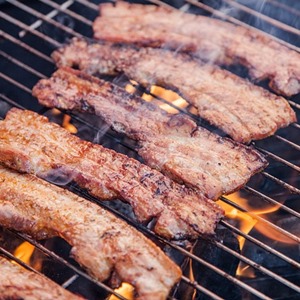 The general rule is to leave the ignite charcoal to burn for 15-30 minutes before you start the cooking session. After you burn it, you have enough time to prepare the meat and double check the ingredients. This 15-30-minute period is there to make sure that every lump catches fire, and ensures an even heat throughout the whole cooking process.
The general rule is to leave the ignite charcoal to burn for 15-30 minutes before you start the cooking session. After you burn it, you have enough time to prepare the meat and double check the ingredients. This 15-30-minute period is there to make sure that every lump catches fire, and ensures an even heat throughout the whole cooking process.
4. Should I use igniting agents to fire up the charcoal?
The safest bet would be to use a twig or a smaller piece of wood to light it. That would be the most natural way, however, this method is not always available. Whichever option you pick, always use solid fire starters, like fire-starting tablets or solid fire-starting fuel. You should absolutely avoid liquid fuels on the count that they are usually toxic when stuck to your food. Also, liquid igniting agents are most likely going to damage the interior of your grill. This goes out especially for people who own ceramic or cast-iron griddles.
5. How should I store lump charcoal?
In most cases, lump charcoal will be packed in a paper, or some sort of low-viscosity polyester bag. After you are done with taking out the needed amount, make sure to store that bag in a dry place. Lump charcoal gets “spoiled” if it catches humidity, and it gets harder to ignite while changing flavor enhancing characteristics.
Also, make sure to store it with no flammable or fire-starting objects or liquids around. In the case of fire, charcoal can burn for longer than anything you have in your garage, so it’s better to be safe than sorry.
Wrap Up
Remember, this is a crucial component of every grill, smoke or sear recipe, and finding the absolute best lump charcoal is as important as finding the best steak, or the best fish to smoke. There is a lot to be learned, but the pay-off is so great that everyone you cook for is going to be grateful you took the time to read our lump charcoal reviews and buying guide.
If you really want to commit, make a list of food you would like to prepare using the newly-acquired coal, and consult this guide. Experiment and play with the flavors and tastes. Some people like their food well done and will opt in for a hotter-burning lump charcoal bag, while some prefer the sweet and mild flavor. It is all up to you and your preferences.
We hope that we got this important topic closer to you, and in case you have any questions or something to add in general, feel free to do it in the comment section below.

great review and i was a big fan of the JD for my green egg until i tried the new Harder XL Charcoal, big chunks and without the small pieces plus price is lower.